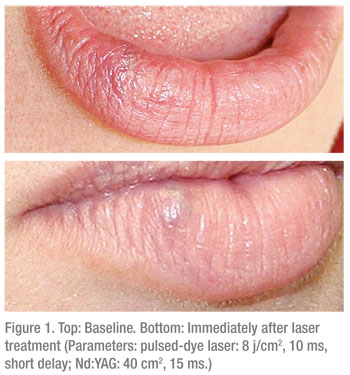 |
History with Laser Science
Ophthalmology is a specialty that has been intricately involved with lasers and laser science since the mid-1900s. Retinal photocoagulation with laser technology was first introduced to the ophthalmologist for treatment of diabetic retinopathy. Since that time, laser science has expanded toward the development of lasers for glaucoma and refractive surgery. Ophthalmologists are uniquely qualified in the field of laser science and optics, with a large portion of their residency programs geared toward laser procedures. It is therefore second nature for aesthetic laser procedures to be of interest in the ophthalmic world.
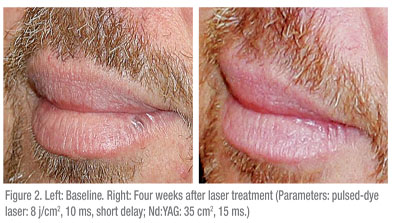 |
Venous Lakes
Venous lakes are commonly acquired, benign vascular ectasias that have a predilection of forming on sun-exposed areas such as the lip and head and neck region of elderly patients. William Bennett Bean and John R. Walsh were the first to publish an article on venous lakes, in 1956.5 They described this vascular lesion as having a nodularity that was compressible. In their publication, they described a disproportionate distribution in male patients.
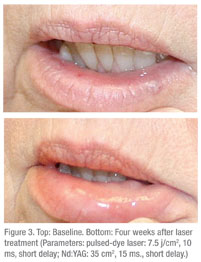 |
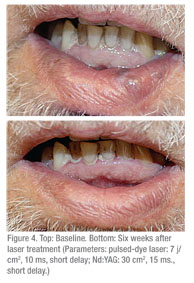 |
Histologically, a venous lake is an ectasia of one or several interconnecting channels arising within deteriorations in the three-dimensional network of connective tissue of the vascular adventia and dermis.6 Typically, no smooth muscle or elastic tissue is found in the vessel wall. Evidence of solar elastosis and other aspects of photodamage can be found in adjacent tissue dermis.7
Venous lakes can be responsive to pulse-dye laser alone when they are small and more superficial. As the lesion increases in nodularity, thickness and depth, longer wavelength lasers are necessary to achieve clinical end results of clearance.
Treatment
Twelve venous lakes in six patients were treated with a dual wavelength vascular laser (Cynergy, Cynosure, Westford, Mass.). All patients were Fitzpatrick skin type III and the male-to-female ratio was 0.66. The median age was 53 years. Five of the six patients had a single lesion located on the lower lip and one patient had seven venous lakes on his lower lip. No patient had received prior treatment for their lesion. No patient received topical or injectable anesthesia during the procedure.
Prior to each treatment, photographs were taken and informed consent discussed and signed.
Dome ocular shields were placed over the patient’s eyes.
A 7-mm handpiece was utilized which was attached to air cooling for epidermal protection (SmartCool, Cynosure). Parameters ranged from 7 to 8 J/cm2 for the pulsed-dye laser with 10 ms pulse duration and a short delay. Fluence for the sequentially pulsed Nd:YAG laser ranged from 30 to 40 J/cm2. Clinical endpoint was a color change from the violaceous original color to a transient darkening followed by a graying color. Each venous lake achieved this clinical endpoint in four or fewer pulses. In one patient, the lesion disappeared to bare perceptibility immediately following laser (See Figure 1).
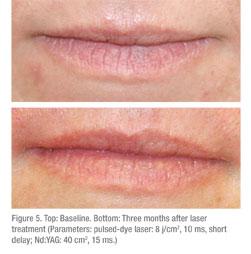 |
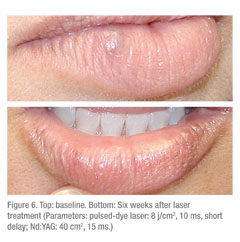 |
All 12 venous lakes had resolved completely at the six-week follow-up period. Every patient was satisfied with his treatment results. (See Figures 2 through 7).
To simplify laser treatment for venous lakes, we looked at a dual-wavelength laser that could be used to treat the full depth of the lesion. The conversion of hemoglobin to methemoglobin by the 595 nm allows for the sequential pulse of the 1,064 nm wavelength to be fully utilized due to the enhanced absorption characteristics of the Nd:YAG laser for methemoglobin over hemoglobin. This translates to lower fluences necessary to achieve clinical resolution and therefore greater patient comfort.
Argon and CO2 lasers have been used to treat venous lakes, however, complicating issues of scarring, textural and pigmented lesions occurred at a higher than acceptable rate.8 Subsequently, chromophore-directed laser treatment emerged and was studied to treat venous lakes.9
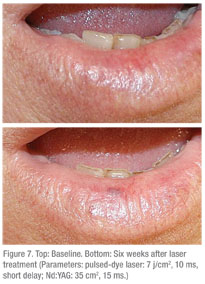 |
Monica Roncero, MD, and colleagues were the first to publish a paper on dual-wavelength laser for venous lakes. Their parameters were slightly higher with the Nd:YAG with longer pulse durations. They achieved a 95-percent clearance rate with their method.
We propose a slightly different set of parameters with shorter pulse durations and lower Nd:YAG fluence than that of Dr. Roncero et al. With these lower fluences, topical anesthesia is not necessary. Dual-wavelength, sequentially emitting 595 nm and 1,064 nm laser achieved 100-percent clearance after one treatment.
Dr. Saluja practices at West Coast Eye Care. She has consulted for Cynosure but has no financial interest in any product mentioned. Contact her at msaluja21@hotmail.com.
1. Suhonen R, Kuflik EG. Venous lakes treated by liquid nitrogen cryosurgery. Br J Dermatol 1997;137: 1018–19.
2. Ah-Weng A, Natarajan S, Velangi S, Langtry JA. Venous lakes of the vermillion lip treated by infrared coagulation. Br J Oral Maxillofac Surg 2004; 42: 251–3.
3. Del Pozo J, Pena C, Garcia Silva J, Goday JJ, et al. Venous lakes: a report of 32 cases treated by carbon dioxide laser vaporization. Dermatol Surg 2003; 29: 308–10.
4. Neumann RA, Knobler RM. Venous lakes (Bean-Walsh)
5. Bean WB, Walsh JR. Venous lakes. AMA Arch Derm. Nov 1956;74(5):459-63.
6. Astner S, Anderson R. Treating Vascular Lesions. Derm Therapy. 2005: 18: 267-281
7. Hernandez C. Venous Lakes. E medicine. Nov. 2009
8. Apfelberg DB, Maser MR, Lash H, Flores J. Expanded role of the argon laser in plastic surgery. J Dermatol Surg Oncol 1983;9:145–51.
9. Cheung ST, Lanigan S. W. Evaluation of the treatment of venous lakes with the 595-nm pulsed dye laser: A case series. Clin Exp Dermatol 2007 Mar;32(2):148-50. Epub 2007 Jan 18.
10. Roncero M, Canueto J, Blanco S, Unamuno P, Boixeda P. Multi wavelength Laser Treatment of Venous Lakes. Dermatol Surg 2009;35:1942–1946



